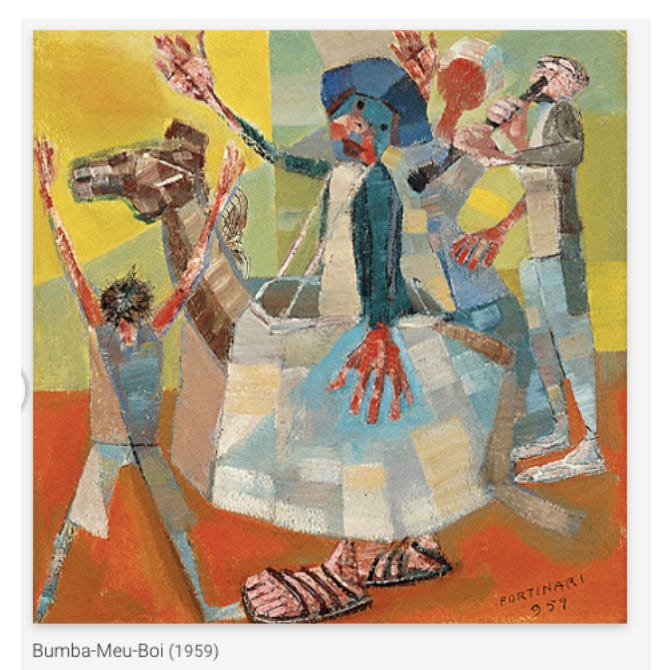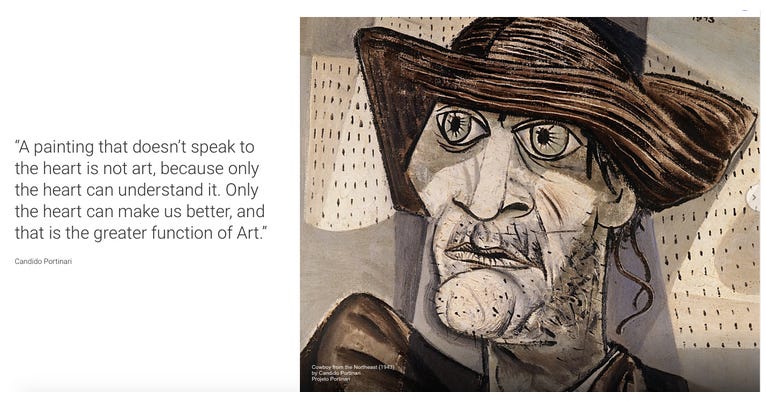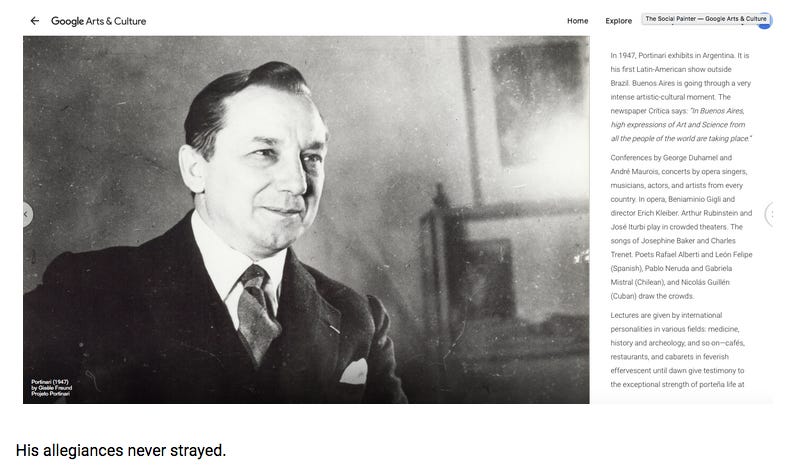May 5, 2025
Candido Portinari, born December 29, 2003 on a coffee-plantation of Brodowski in Brasil’s sourthern Estado of Sao Paolo, and passed on February 6, 1962 in Rio de Janeiro, and his splendid, multiply evocative paintings have come to mind often over this past month. From first viewing, while aboard a Varig Airlines Flight from Los Angeles to Rio for the Maratona there in July 1982, Portinari’s works surprised, absorbed and delighted me. I hope that you enjoy him, too.
Candido Portinari, Painter
The two images above are from a prodigious gallery of work by Candido Portinari, 'Projeto Portinari', that resides online.
Here’s how I encountered Portinari. July 1982, I was flying from San Francisco by way of Los Angeles and on to Rio de Janeiro to compere in the Maratona there. Varig Airlines in-flight magazine featured one article, with sumptuous photos, that gratified me: ‘Mulatta / Flower of Miscegenation.’ A second piece was even more resplendant. It splashed effervescent azures and cornsilk yellows and earthen-clay reds across pages as the plane from L. A.crossed above the Amazon toward Rio de Janeiro. I carried the warmest of Romantic expectations to Brasil, a beacon to me since I was eight years old and transported from Whatcom County by a red Hammond Atlas. Candido Portinari's paintings pleased me like an unexpected but desired gift. I was coming to Rio to run, thanks José and the Jornal do Brasil and an appearance-fee, and here was art--in an Airlines' magazine!--of a brightness and majesty and inventiveness comparable to feathers in "Black Orpheus"!
I thought, too: Why is this painter not famous in North America like, say, peers such as Willrm de Kooning and Helen Frankenthaler?
Later I learned more. Portinari’s decades of work consistently revealed wonders of empathy and imagination. The boy was born among poverty on a coffee plantation in 1903. The man died from paints' poisoning in 1962, amid veneration and still flowering creativity. He stayed true to sentiments that first animated his art: lways one with those who work the hardest and the least. Their struggling and stoicism were his and so were their pleasures and joys.
Portinari's sympathies never left workers in the highlands-and-plantation town of Brodowski.
Portinari's international ascent was swift. Rene Huygens', Director of the Louvre in Paris, greeted the Brasilian in 1937. 'I consider Portinari one of the greatest painters of our time. His strength is enormous.' Jean Cassou of Paris' Museum of Modern Art said: 'Portinari is, without a doubt, the greatest painter in Latin American and one of the greatest contemporary painters.' The United States' Poet Laureate in 1942, Archibald MacLeish, invited Portinari to contribute four murals to the Library of Congress.
The painter was lauded in Argentina and Uruguay during their 'ferment' in the latter 1940s. He'd had to flee Brasil after running for Senate as a Communist.
Candido Portinari died in early 1962 at age 59 . He'd refused doctors' advice to back off from painting.
He was beloved from his 20s onward in Brasil--as the Varig Airlines' piece of 1982 manifested--but his public presence diminished during the Military Dictatorship that started with a coup in 1964 and lasted for 23 years. His son Joao Candido Portinari, a Doctor of Engineering at the Massachusetts Institute of Technology, led an effort to catalogue thousands of pieces.
Now, more than 3500 of Candido's paintings available on view online through Projeto Portinari.
Also, Google--whatever one may think of Google as an absurdly dead-ended and robotic ‘transhumanist’ engine and vehicle--has provided its 'Arts & Culture' resources as a platform for the art and life of Candido Portinari.
Freedom and compassion made him, as it their combination enabled the careers of Mohammad Iqbal and Vivian Maier and Paul Fussell’s great book of expressions from those sacrificed in the first of World Wars. May we be moved away from WEF-Dumb by their examples!















